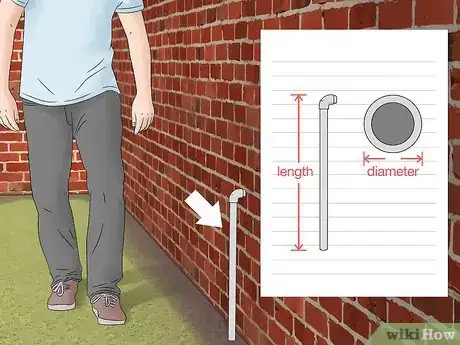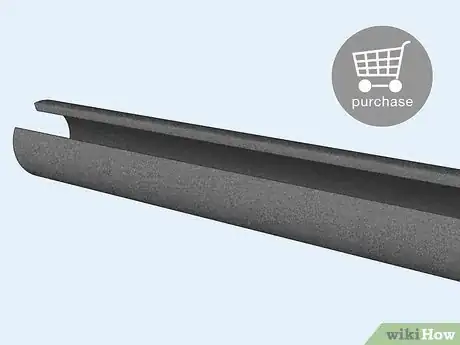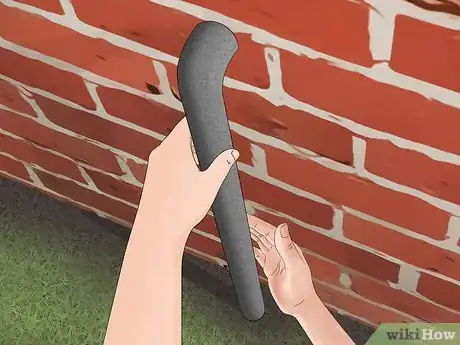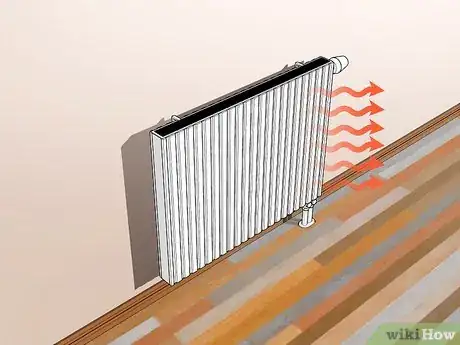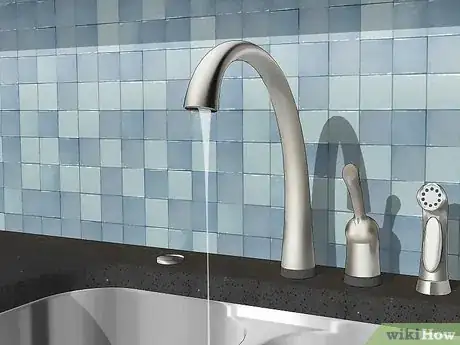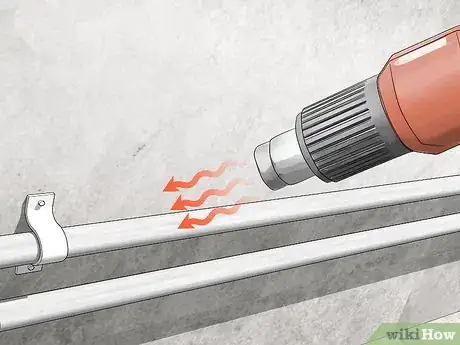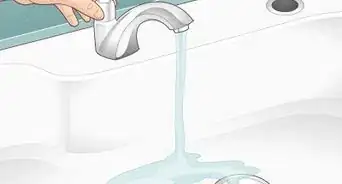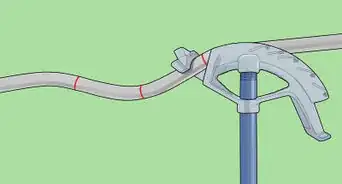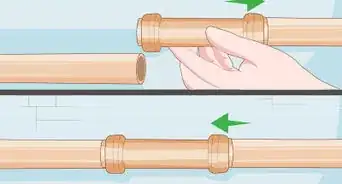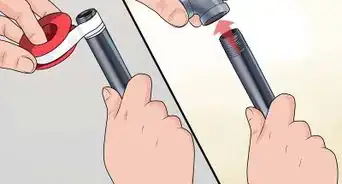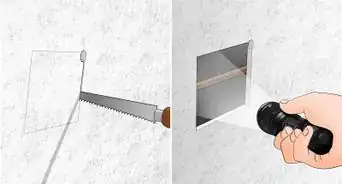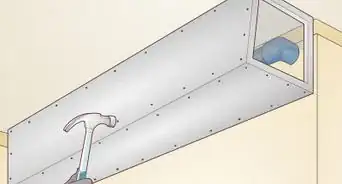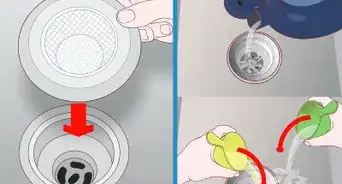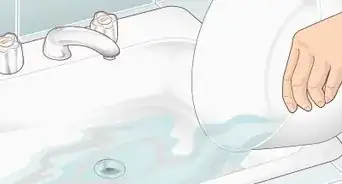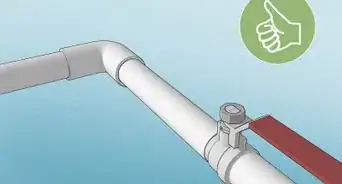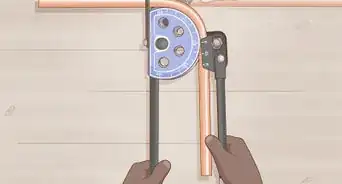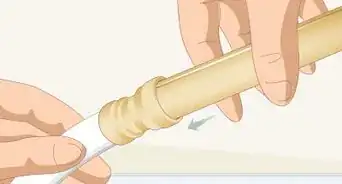This article was co-authored by David Balkan and by wikiHow staff writer, Eric McClure. David Balkan is a Professional Plumber, CEO of Balkan Sewer and Water Main Service, and President of Balkan Sewer and Drain Cleaning. As a hands-on owner of these companies for over 40 years, David is knowledgeable about water service lines, sewers, and drain line issues. David is a Committee Chairman of the Master Plumbers Council and has sat on the Executive Committee of the Sub Surface Plumbers Association of New York for over 30 years. His knowledge and solution-oriented approach contributed to Balkan Sewer and Water Main Service being the largest and most trusted service in New York City and the recipient of the 2017 Angie’s List Super Service Award.
This article has been viewed 82,286 times.
Preventing exterior pipes from freezing isn’t hard to do, but it is important. A frozen pipe may burst, which can lead to expensive and time-consuming repairs. To keep exterior pipes from freezing, protect them with polyethylene pipe insulation and duct tape. In your home, turn the heat on until the weather warms up and keep your cabinet doors open underneath your sink. Leave your sinks on so that a thin trickle of water comes out and keeps the pipes from freezing. In the event that a pipe does freeze, you can use a hair dryer or heating pad to warm the pipe up and clear the ice.
Steps
Insulating Your Pipes
-
1Survey your exterior pipes to determine which pipes to insulate. Grab a pen, paper, and a measuring tape, and take a walk around your home. Identify any pipes that you want to cover. Measure the length of each exposed pipe that you want to insulate and write it down. For each pipe, note the diameter next to the length.[1]
- If your house is on risers, get a disposable crawl suit and a flashlight to crawl into your crawlspace and look at your pipes.
- You can tell if a pipe has water in it by putting your ear up to it and listening carefully. You should be able to hear water rushing through it. You can also tap it with a screwdriver. If the sound is hollow, it probably doesn’t have water inside.
- You don’t really need to insulate pipes that contain wires, but you can if you’d like. Pipes that contain wires are typically silver and made of metal. Copper, PVC, or cast iron pipes are more likely to carry water.
Tip: This process is best completed when it’s still warm out. If your pipes are already cold when you insulate them, the insulation will take a long time to warm the pipe up.
-
2Purchase polyethylene insulation for your pipes. Take your list of measurements to your local construction or home repair store. Buy enough pipe insulation to cover all of your pipes by matching the inside diameter of the insulation to the outside diameter of your pipes. The length and interior diameter of a piece of insulation is listed on the packaging, so read the label carefully before buying your insulation.[2]
- For example, if you have 2 pipes with identical diameters that measure 12 inches (30 cm) and 40 inches (100 cm), you need at least 52 inches (130 cm) of insulation. It’s always a good idea to have some extra insulation on hand, though!
- Polyethylene looks like a black foam and is the most commonly-used material to insulate exterior pipes. Fiberglass sleeves are typically used to insulate interior pipes. If you’re using fiberglass sleeves, wear a dust mask, gloves, and protective eyewear.
- Pipe insulation is precut so that it can wrap around the pipe easily. You can cut it to length with scissors if needed.
- For pipes that are protected from the elements, you can use an electrical heating tape—just wrap it around the pipes and plug it in to keep your pipes warm.[3]
Advertisement -
3Wrap insulation around each of your exposed pipes by hand. To wrap insulation around a pipe, find the vertical seam where the insulation is cut. Dig your fingers into this seam and gently pull the insulation open. Press the inside of the insulation around the pipe and let go of both sides to attach the insulation to the pipe. Repeat this process for each pipe that you’re insulating.[4]
- Put on a pair of gloves before doing this to avoid burning your hands on hot water pipes.
-
4Secure the insulation with duct tape or cable ties. To keep your insulation from sliding off of your pipes, use duct tape or cable ties. Wrap duct tape around the base of the insulation 4-5 times and pull it tight to keep the insulation in place. Attach cable ties by wrapping the plastic tie around the pipe and threading one end of the tie through the opening on the other end. Secure the tie by pulling firmly on the length that slides through the opening. Work your way up and wrap duct tape or place a cable tie once every 2–4 feet (61–122 cm). Repeat this process for every pipe.[5]
- Don’t pull so hard on your pipe that you end up ripping it out or cracking it. So long as the ties or tape keep the insulation from sliding around, you’re fine.
Using Water and Air to Prevent Freezing
-
1Turn the heat on inside your home and leave it at a steady temperature. Keeping your home heated will ensure that the walls stay warm. If the walls are warm, the pipes leading inside will have a harder time freezing. Turn the heat on to a temperature higher than 65 °F (18 °C). Leave the heat where it is and don’t turn it down or off when you leave or go to bed.[6]
- You don’t need to set the thermostat to its highest setting to keep your home warm. So long as the air in your home is 55 °F (13 °C) or hotter, your pipes will be less likely to freeze.
- Use a space heater or free-standing radiator to heat rooms that have poor circulation. Don’t leave a space heater on when you aren’t home or go to sleep, though.
-
2Open the cabinets under your sink to improve air flow. Hot air has trouble making its way into your cabinets where your exterior pipes lead inside. To prevent exterior pipes from freezing, improve the air flow where the pipes enter into your home. Go to every sink in your home and open the cabinet doors. Leave them completely open to allow the hot air in your home to make its way under the sink.[7]
- Keeping your interior pipes warm will prevent the exterior pipes from freezing up.
- If you have a garage, keep the door closed. Many garages have water lines running underneath or alongside them.
-
3Let water drip from each of your faucets to keep water flowing. Your pipes can’t freeze up if the water is constantly moving. To keep water moving through your pipes, turn the handle on each of your sinks and tub 1–2 inches (2.5–5.1 cm) to leave a trickle of cold water running at all times.[8]
- This will increase the price of your water bill, but it’s worth it to avoid spending thousands of dollars on a burst pipe that leads to water damage.
Tip: Don’t use hot water to keep the water flowing. Your hot water heater won’t be able to keep up with the demand and you’ll just end up running out of hot water.
Thawing a Frozen Pipe
-
1Turn the water on to apply pressure to your pipe. If a pipe freezes, turn on the water at each sink and tub in your home. If water starts building up or no water comes out, your pipe is fully blocked. Turn your frozen faucet off to avoid overflowing your sink or tub. Leave the other lines running while you deal with the blocked pipe by heating it directly.[9]
- Don’t worry if the water backs up. It’ll go down as soon as you heat the pipe directly and the pressure from the water will make this process easier.
- It’s usually pretty easy to find a frozen pipe. Simply go to the wall outside of the sink or drain where you’re experiencing problems. You’ll find the pipe leading out of the wall or base of your home.
- The supply line is frozen if no water comes out. The drain line is frozen if water won’t go down.
-
2Use a heating pad or hair dryer to heat a frozen pipe directly. To thaw a pipe out, take a portable heating pad or hair dryer out to the pipe. Turn the heating pad to its highest setting and wrap it around the frozen section. If you’re using a hair dryer, turn it on to the highest setting and run it over the frozen length. After heating the pipe for 10-15 minutes, check your sink to see if the water has gone down or come back on. If it hasn’t, repeat this process until the pipe is fully thawed.[10]
- If you don’t have a portable pad or hair dryer, find an outlet outside and use an extension cord to reach your pipe.
- You can also soak a towel in hot water and layer it around the pipe. This may work, but the towel will freeze if you leave it on for too long.
Warning: Do not use a blowtorch or gas heater. These tools can heat the pipe too rapidly and may cause an explosion.
-
3Call a licensed plumber if you cannot clear the blockage or find the pipe. If you cannot clear the blockage after 30-45 minutes of heating the pipe, there may be a blockage underground or in your wall. If you can’t find the pipe, you may need help identifying the source of the problem. Call a licensed plumber immediately to clear the blockage for you. The longer a pipe remain frozen, the more likely it is to burst.
- A burst pipe can lead to costly repairs and permanent water damage that will require heavy renovations.
Things You’ll Need
Insulating Your Pipes
- Measuring tape
- Pen or pencil
- Paper
- Crawl suit (optional)
- Flashlight (optional)
- Pipe insulation
- Scissors
- Duct tape or cable ties
Thawing a Frozen Pipe
- Hair dryer
- Heating pad
- Extension cord (optional)
References
- ↑ https://www.energy.gov/energysaver/services/do-it-yourself-energy-savings-projects/savings-project-insulate-hot-water-pipes
- ↑ https://www.energy.gov/energysaver/services/do-it-yourself-energy-savings-projects/savings-project-insulate-hot-water-pipes
- ↑ David Balkan. Professional Plumber & CEO of Balkan Sewer & Water Main. Expert Interview. 23 February 2021.
- ↑ https://todayshomeowner.com/video/how-to-insulate-water-pipes-to-prevent-freezing/
- ↑ https://www.energy.gov/energysaver/services/do-it-yourself-energy-savings-projects/savings-project-insulate-hot-water-pipes
- ↑ https://www.redcross.org/get-help/how-to-prepare-for-emergencies/types-of-emergencies/winter-storm/frozen-pipes.html
- ↑ https://www.redcross.org/get-help/how-to-prepare-for-emergencies/types-of-emergencies/winter-storm/frozen-pipes.html
- ↑ https://www.consumerreports.org/home-maintenance-repairs/how-to-keep-pipes-from-freezing/
- ↑ https://www.consumerreports.org/home-maintenance-repairs/how-to-keep-pipes-from-freezing/
